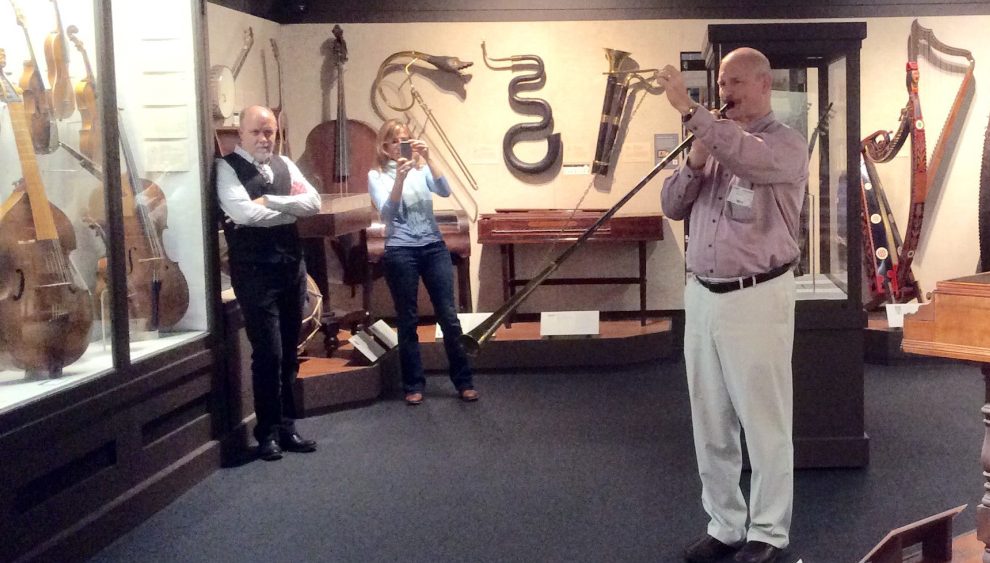
The Boston Salpinx Project
Terry Everson playing the Boston Salpinx at the Museum of Fine Arts (MFA) in Boston
(MFA Curator Darcy Kuronen and Kirsty Montgomery looking on)
The Boston Salpinx
One of the most fascinating instruments discussed in Around the World in Twenty-One Trumpets is the salpinx, the trumpet of ancient Greece. There is only one complete authentic salpinx (pictured below) which is housed at the Museum of Fine Arts (MFA) in Boston, MA. It is comprised of 13 sections of bone connected with bronze rings, a conical bell and mouthpiece (also made of bronze), and a chain, which appears to have been connected to the bell, possibly to help the player to hold it up, or to keep it from falling apart while playing.
"Around the World in Twenty-One Trumpets" explores what is known about both the cup-bell and cone-bell salpinges, as well as how and what salpinktes (salpinx players) might have played on them. In addition, it explores the use of the salpinx in the Olympic games to inspire students to develop their skills, both technically and musically. The curriculum also tells the story of Herodorus of Megara, a ten-time Olympic champion and renowned military trumpeter, who could play two trumpets simultaneously. (Spoiler alert: watch out for Ragnar stealing the glory in Lesson Eight)
When we learned that the MFA had a playable replica of the salpinx, we contacted the curator of musical instruments, Darcy Kuronen, who generously offered to make the instrument available to us to see. Our plan was to record sound files to accompany Lesson 8: Trumpet Olympics. We needed an extraordinary trumpeter to take on this challenge, so I asked long time friend and colleague, Terry Everson (Boston University Professor of Trumpet) if he would be interested in playing the part. For those who know Terry’s trumpet playing, he would certainly qualify as an Olympic trumpeter, so we were thrilled that he was interested and willing to record on an instrument that was completely foreign to him.
We traveled to Boston in late November 2014 and met Darcy Kuronen and Terry Everson at the MFA where we examined the original salpinx and assembled the replica. Mr. Kuronen spent a lot of time with us, providing all the information he had on the instrument and explaining its history, while Terry began to play it in preparation for recording. After the museum closed we set up recording equipment while Terry began to explore the musical capabilities of the instrument. Due to the fact that most of its length is cylindrical, and the bell has a small conical flare, the instruments series of natural notes sound quite different than a modern trumpet. Additionally, the lack of cup and backbore in the mouthpiece (pictured below) makes the response less than desirable.
In order to hold up the instrument (and to keep it from falling apart) the player must grip a chain that is attached to the bell. I had personally been looking forward to playing this instrument for some time, but because of the issues mentioned above, I found it extremely challenging to play.
After exploring the harmonic series, inflections, articulations, and dynamic range (the power/volume of sound was likely one of the main criterion for judging Olympic contestants in ancient Greece), Terry began to improvise. It is known that the salpinx was used for entertainment at street festivals and parades, so we had asked him if he could play song-like or dance-like music as well. It was a moving experience to hear Terry breathe life into this two-thousand year old instrument (or, at least, its replica) and we are delighted to be able to share this experience with BFB students and educators. Click here to hear the sound files, and enjoy the video of Terry Everson playing the salpinx (below).
We want to thank Darcy Kuronen and Terry Everson for making this amazing experience possible.
For those wanting to know more about the salpinx, please scroll down to “Suggestions for Further Reading.”
Video
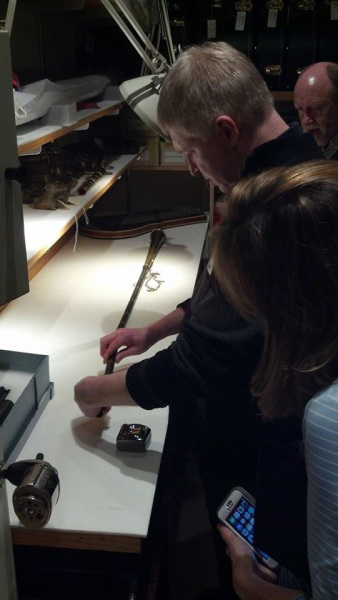
BFB author Chris Hasselbring assembling the replica of the salpinx
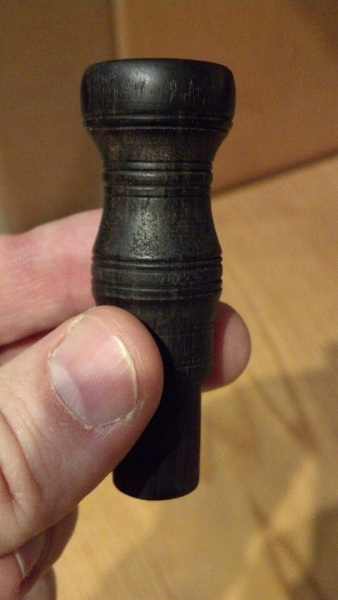
Replica of the salpinx mouthpiece- the original was made of bronze
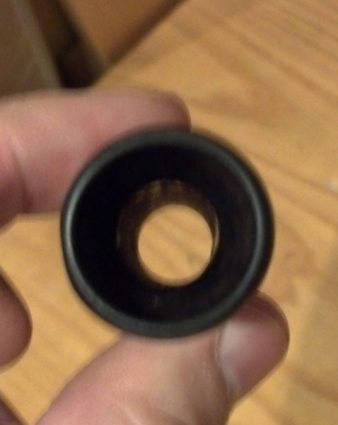
Cup and backbore of the salpinx mouthpiece replica
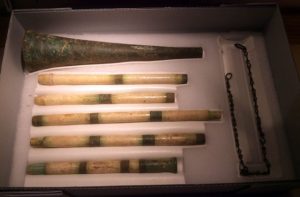
The Boston Salpinx
Suggestions for Further Reading:
Hale, John R. and Michael H. Tunnell. “The Greek Trumpet Project: An Experiment in Popular Education.” Classical Bulletin, Vol. 72, No.2, (1996), pp. 118-124.
Holmes, Peter. “Prehistoric Brass Instruments.” World Archaeology, Vol. 12, No.3, Archaeology and Musical Instruments (Feb., 1981), pp. 280-286.
Montagu, Jeremy. Horns and Trumpets of the World: An Illustrated Guide. New York and Plymouth: Rowman & Littlefield, 2014.
Wallace, John and Alexander McGrattan. The Trumpet. The Yale Music Instrument Series. New Haven and London: Yale University Press, 2011.
West, M. L. Ancient Greek Music. Oxford: Oxford University Press, 1992.
Wagner, Mayke et al, “The ornamental trousers from Sampula (Xinjiang, China): their origins and biography, ” Antiquity, Dec. 2009, Vol. 83, 322, pp. 1065-1075.
Xanthoulis, Nikos. “The Salpinx in Greek Antiquity.” International Trumpet Guild Journal, (Oct., 2006), pp. 39-45.